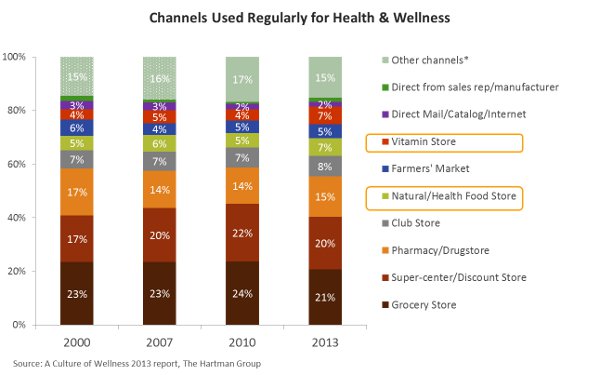Shopping for Wellness Begins With Food and Beverage
 The health and wellness market continues to be a dynamic growth area. The puzzle for many is understanding how the wellness market intersects with their business, brand and category. In few places does the market so vividly present itself as an opportunity as it does for America’s food retailing industry.
The health and wellness market continues to be a dynamic growth area. The puzzle for many is understanding how the wellness market intersects with their business, brand and category. In few places does the market so vividly present itself as an opportunity as it does for America’s food retailing industry.
Where shoppers go to buy their wellness products has changed considerably over the years. In 2000, the supermarket and grocery store channel dominated the market for food and groceries, and it commanded a significant share of the personal care and household products as well. While the grocery channel is still the most commonly used across all segments of consumers, supercenters, mass discounters, natural food stores, club stores and specialty retailers have all made inroads.
As the following chart from our A Culture of Wellness 2013 report illustrates, consumers continue to source health and wellness products from a wide array of channels. It also shows that the increased reliance in 2010 on discount, dollar and grocery at the expense of more specialized health and wellness channels has subsided as consumers returned some of their business to specialty in 2013.

Although we’ve all heard the refrain that consumers complain about having to go grocery shopping, we do not often realize how this activity helps provide some familiarity and a sense of security in today’s complex, busy and stressful lifestyles. Even as many daily activities become automated or, in many instances due to technological advances, eliminated, feeding ourselves and our families remains a necessary daily activity. And the reality that foods and beverages are the primary wellness vehicle for consumers and that foods and beverages can be obtained just about anywhere (what we call the “roadside pantry effect”) only compounds the conundrum for retailers of just what “wellness at retail” means.
Shopping for Wellness: A “Healthy Store” Starts in the Fresh Department
Consumers now source health and wellness products and brands wherever they shop, as more products and brands once the staple only in natural and specialty channels are now everywhere. This is even truer today, since fresh, less processed foods are now the dominant wellness tool.
The trend toward fresh continues to be evident as consumers are purchasing more fresh categories than packaged or prepared categories, and this becomes more evident from the Periphery to the Core. Consumers evaluate stores on their ability to provide a full range of fresh offerings in produce, meat, deli, cheese and bakery categories.
The “fresh focus” influences consumers’ perceptions of brands. Brands that cue “fresh” with organic ingredients, ingredients that are easy to pronounce, few ingredients, minimal packaging, etc., are deemed wellness brands.
Brands, products and signage for food sensitivities (gluten, nuts, dairy), specialized diets (vegan, paleo, gluten-free) and ethnic foods create a feeling that retailers care and are keeping up with the greater food culture.
How do consumers navigate the retail setting for health and wellness products?
Because shopping is habitual and complex, consumers are primarily navigating for health and wellness products by:
- Departments: “produce is all healthy”
- Familiar products/brands: “when I see it, I’ll know it”
- Familiarity with a twist: “when something new catches my eye that I’ve heard about or wanted to try”
- New agenda: “when I’m look for something specific I’m trying to find, like gluten-free or dairy-free”
- Ingredient list: “what’s in it?”
- Prices: “why pay more?”
Our Health & Wellness 2013 research also finds that most consumers are not aware of nutritional labeling, and when made aware they struggle with irrelevant, insufficient and/or inconsistent information.
Wellness Retail Experience
Remember, consumers determine the healthfulness and helpfulness of a retailer by:
- Category editing: what foods it chooses to have AND not have, and the balance of these
- Visual display: how and which foods are displayed, which reveals values and mission
- Store vibe: how it feels to be in a store, which is the sum total of its staff, in-store design and sensory cues, product curation and other shoppers
For the most comprehensive data, information, insights and The Hartman Group’s signature “ahead-of-the-curve” thinking on the health and wellness consumer and opportunity spaces, sign up to participate in our Q2 syndicated study: Health & Wellness 2015, Tracking the Role of Food and Beverage in an Evolving Culture of Wellness.
